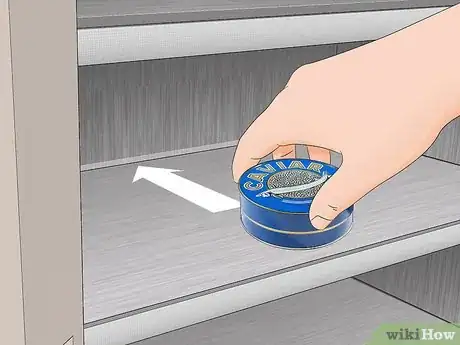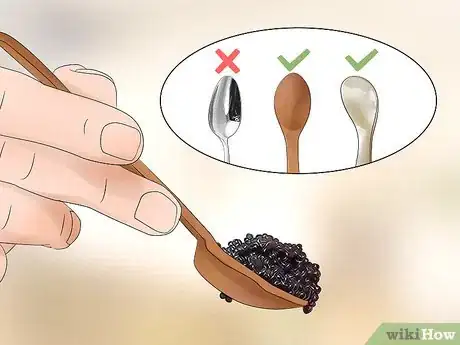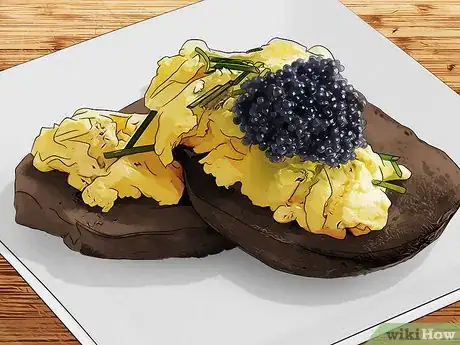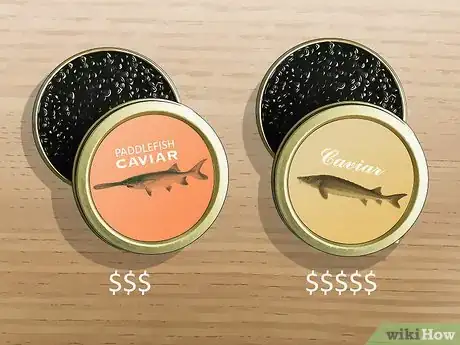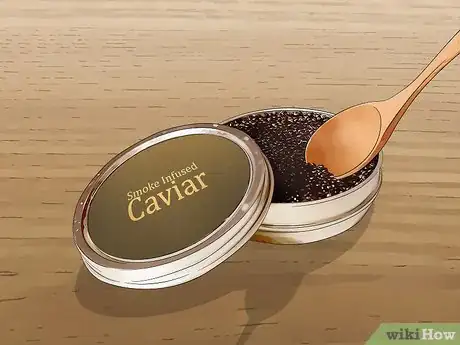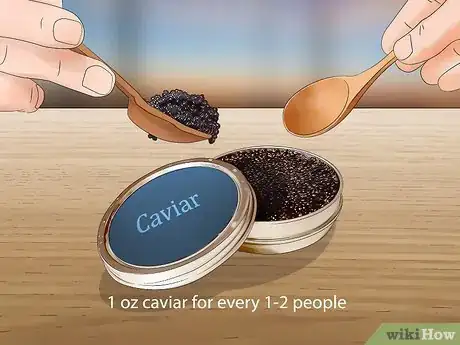This article was co-authored by wikiHow staff writer, Amy Bobinger. Amy Bobinger has been a writer and editor at wikiHow since 2017. She especially enjoys writing articles that help people overcome interpersonal hurdles but frequently covers a variety of subjects, including health and wellness, spirituality, gardening, and more. Amy graduated with a B.A. in English Lit from Mississippi College in 2011 and now lives in her hometown with her husband and two young sons.
There are 9 references cited in this article, which can be found at the bottom of the page.
wikiHow marks an article as reader-approved once it receives enough positive feedback. In this case, several readers have written to tell us that this article was helpful to them, earning it our reader-approved status.
This article has been viewed 415,206 times.
Learn more...
Caviar is a delicacy made from harvested roe, or fish eggs. Typically made from sturgeon roe, caviar is highly sought after for its sweet, buttery, and nutty flavor. While caviar is often regarded as being very expensive, some grades are actually more affordable than you might think. Once you choose your caviar, experiment with different ways to serve or prepare it. For instance, you might choose to eat it plain so you can savor the flavor, or you might serve it on top of blinis with chives and eggs.
Steps
Serving and Tasting Caviar
-
1Store your tin of caviar in the back of the refrigerator. Typically, the back of the refrigerator is the coldest part, which will help preserve the flavor and texture of the caviar. Do not open the tin until you are ready to eat it, as this will decrease its shelf life.[1]
- It is a good idea to only purchase the amount you expect to eat in a single sitting. However, if you do have leftover caviar, return it to the original tin, place a piece of plastic wrap over the top, and close the tin securely. Then, put the tin back into the refrigerator for 1-3 days to keep the taste fresh.
-
2Use a bone, crystal, or mother of pearl spoon to handle the caviar. To preserve the flavor, only use coated dishes and spoons when you're serving caviar. Avoid serving the caviar with a metal spoon or dish, as the delicacy will absorb the metal flavors. If you do not have one of these special spoons, grab a simple plastic or wooden spoon instead.[2]
- You can purchase caviar spoons at your local department store in the kitchenware section or online with major retailers.
Advertisement -
3Keep the caviar chilled on crushed ice while you have it sitting out. Caviar is a delicate dish that should be kept chilled. This will help preserve the flavors and quality of the product.[3]
- You could also rest the caviar bowl on an ice pack if you don't have any crushed ice on hand.
-
4Eat a small spoonful of plain caviar to experience the subtle flavor. To get the most from the experience, bring the caviar to your nose and inhale the aroma, then taste a small amount. Try not to chew the caviar or you might miss some of the more subtle flavors, as well as the unique texture. Instead, use your tongue to roll the eggs around in your mouth.[4]
- Caviar is very rich, and it’s meant to be tasted or served in small amounts. If you are eating it plain, aim for 1/2 tsp (2.67 g) of caviar per tasting. If you are including it in a meal or as an appetizer, use approximately 1-3 tsp (5.33-16 g) of caviar.[5]
-
5Sip on a glass of chilled vodka or champagne to cleanse your palate. Since caviar is a traditional Russian delicacy, it is often paired with vodka. The vodka complements the flavors of the caviar and cleanses your palate between tastings. If you’d prefer something a little lighter, though, caviar and champagne go together very nicely.[6] [7]
Tip: You could also pair the caviar with sparkling wine, like a Prosecco, or dry, white wine, like a Sauvignon Blanc or Pinot Grigio.
Pairing Caviar with Other Foods
-
1Roll up a blini with caviar and chives for a classic appetizer. Place a small serving of caviar on top of a warm blini, then sprinkle that with chives. If you'd like, you can also add sour cream or butter to enhance the creamy texture of the caviar. Roll up the blini and enjoy![8]
- A blini is a Russian pancake or crepe that is made from wheat or buckwheat flour.
-
2Top a toast point with crème fraiche and caviar for a crunchy-creamy combination. Toast bread and cut off the crusts, then cut the bread in quarters from corner to corner to create 4 small toast triangles. Place a spoonful of crème fraiche onto each toast point, then top that with a spoonful of caviar.[9]
- Not only do the contrasting textures make this a delicious appetizer, but the caviar looks beautiful on top of the white crème fraiche.
- If you want to include your own twist on this appetizer, try adding sliced hard-boiled eggs, butter, a spritz of lemon juice, diced red onion, or chopped chives.[10]
Did You Know? Crème fraiche is a tangy mixture of heavy cream and buttermilk, sour cream, or yogurt. It’s sold at most well-stocked grocery stores, but you can also make your own!
-
3Eat the caviar for breakfast with eggs and buttered black bread. The texture of scrambled or over-easy eggs blends nicely with the creamy texture of the caviar. Put that over a thick slice of tangy, nutty black bread for a hearty breakfast.[11]
- If you’d like, you can garnish the whole thing with minced red onions to add a sharp contrast.
- Black bread is similar to a dark rye bread, but it contains fennel seeds and vinegar, so it has a tangy flavor with notes of licorice. For a more subdued flavor, use traditional Jewish rye bread instead.
-
4Spoon caviar over a twice-baked potato to elevate a family favorite. Bake a potato at 400 °F (204 °C) for 1 hour, then cut it in half and spoon out the inside. Mix the inside of the potato with minced chives, butter, milk, bacon, cheese, sour cream, salt, and pepper. Spoon the mixture back into the potato skin and bake it again at 350 °F (177 °C) for 15-20 minutes. Top the potato halves with a caviar of your choice and enjoy![12]
- If you like caviar, there’s no need to save it for special occasions! Caviar can add a creamy, nutty element to a number of your favorite dishes. For instance, you could also try adding it to egg salad, since the texture of the caviar blends nicely with the creaminess of the eggs.
Purchasing Caviar
-
1Purchase your caviar from a reputable seller to get the most for your money. Whether you want an inexpensive tin of caviar to try it for the first time or you’re interested in trying a high-end variety, you’ll get a higher-quality product from an established caviar maker. When you find a store near you that carries caviar, research some of the brands you find in the shop to determine which ones have been making caviar the longest, and whether they have a good reputation in the industry.[13]
- Some popular sellers include Petrossian, Khavyar, Sterling, Dean & DeLuca, Russ & Daughters, and Zabar’s.
-
2Choose a lower-grade caviar if you’re shopping on a budget. Caviar is sold by grade, but don’t be put off by the descriptions “mid-grade” or “low-grade.” As long as you’re purchasing caviar from a well-known brand, even the lower grades will still be high-quality, especially as you’re just acquiring the taste.[14]
- Mid and low-grade caviar include eggs from the Israeli, European, and American ossetra sturgeon; the Siberian sturgeon; the white sturgeon; and the American Hackleback sturgeon. The hackleback sturgeon is particularly known for its buttery flavors, and affordable pricing that can be as low as $20.00 (17.19 euros) per ounce.[15]
Did You Know? The most expensive versions typically have subtleties in their flavor, color, and texture that you might not be able to detect when you first start eating caviar.
-
3Opt for non-sturgeon caviar for an even more wallet-friendly choice. Non-sturgeon caviar is usually a more affordable option for people who would like to experiment with using caviar in different recipes. The most popular non-sturgeon roe come from paddlefish, bowfin, and salmon.[16]
- Paddlefish caviar is made of small, silver eggs. It’s typically the most expensive of the non-sturgeon caviar variety, starting around $25.00 (21.48 euros) per ounce.
- A lower-priced non-sturgeon caviar would be from the bowfin fish that starts around $12.00 (10.31 euros) per ounce. The bowfin is highly regarded for its strong nutty flavors.
- Some other non-sturgeon caviar includes the eggs from salmon and capelin.
-
4Buy high-grade caviar if you already enjoy eating it. Once you become familiar with the taste and texture of caviar, your palate will become more sensitive. This means that you’ll be able to distinguish and appreciate the subtle differences in flavor and taste that are found in a high-grade caviar.[17]
- Caviar made from Caspian Sea sturgeon roe, specifically the beluga, ossetra, and sevruga species, is considered the finest delicacy. However, since the sturgeon species found in the Caspian Sea are endangered, the caviar from these fish is a banned import to a number of countries.
-
5Try caviar with added flavors if you’re feeling adventurous. Flavored caviar is typically not considered high-end, but it can be a fun way to introduce yourself to caviar while experimenting with different flavors. Some store-bought flavors include wasabi, lemon, ginger, or smoke-infused caviar.[18]
- If you find flavored caviar, try pairing it with other flavors that will compliment it. For instance, if you're enjoying caviar flavored with lemon, you might serve that on toast points with a creamy, tangy topping like sour cream.
-
6Purchase at least 1 oz (30 g) of caviar for every 1-2 people. Although caviar is meant to be served in small portions, you still want to make sure you have enough to enjoy. Caviar is often sold in 1 oz (30 g) tins, which is enough for 2 people to have a small amount. However, if you have the budget for it, try to serve about 1 oz (30 g) per person.[19]
- Having a large enough serving will allow the flavors to fully develop on your palate.
-
7Ask to taste the caviar before you purchase it. Most high-end retailers will allow you to sample the caviar before you make a decision on which one to buy. If that’s the case, narrow your pick down to 1 or 2 options in your price range, and ask to taste each one. To ensure you get the quality you think you are, ask to be served from the same tin you’re planning to purchase.[20]
- If the caviar is in a clear glass jar instead of a tin, you will be able to tell the quality of the product just by looking at it. High-grade caviar will consist of large, lightly colored eggs. Medium or low-grade caviar will consist of small, dark-colored eggs.[21]
Community Q&A
-
QuestionShould I rinse the caviar with water before serving from the jar?
 Community AnswerAbsolutely not! You will be just pushing money down the drain. It is already processed and ready to eat.
Community AnswerAbsolutely not! You will be just pushing money down the drain. It is already processed and ready to eat. -
QuestionDo I have to eat it all at once, or can I save it for later?
 Community AnswerYou can save leftover caviar in the fridge, but only for 3 days. Make sure that you keep it on the very bottom shelf or drawer of your fridge.
Community AnswerYou can save leftover caviar in the fridge, but only for 3 days. Make sure that you keep it on the very bottom shelf or drawer of your fridge. -
QuestionHow many spoons at one time I can eat?
 Community AnswerIt depends on how much you want. There is no limit saying you can only eat this much. Eat as much caviar as you feel like eating.
Community AnswerIt depends on how much you want. There is no limit saying you can only eat this much. Eat as much caviar as you feel like eating.
References
- ↑ https://whatscookingamerica.net/Appetizers/CaviarPlate.htm
- ↑ https://www.seriouseats.com/2013/02/the-serious-eats-guide-to-how-to-buy-caviar.html
- ↑ https://www.cnn.com/travel/article/caviar-concierge-tips/index.html
- ↑ https://www.foodandwine.com/news/myths-how-to-eat-caviar
- ↑ https://www.cnn.com/travel/article/caviar-concierge-tips/index.html
- ↑ https://www.foodandwine.com/news/myths-how-to-eat-caviar
- ↑ https://whatscookingamerica.net/Appetizers/CaviarPlate.htm
- ↑ https://www.bbc.com/food/recipes/dillbliniswithcaviar_86321/
- ↑ http://stylecaster.com/complete-guide-on-how-to-buy-and-eat-caviar/
- ↑ https://whatscookingamerica.net/Appetizers/CaviarPlate.htm
- ↑ https://www.foodandwine.com/news/myths-how-to-eat-caviar
- ↑ https://whatscookingamerica.net/Vegetables/CaviarPotatoes.htm
- ↑ https://www.seriouseats.com/2013/02/the-serious-eats-guide-to-how-to-buy-caviar.html
- ↑ https://www.seriouseats.com/2013/02/the-serious-eats-guide-to-how-to-buy-caviar.html
- ↑ https://www.foodandwine.com/blogs/how-buy-caviar
- ↑ https://www.foodandwine.com/blogs/how-buy-caviar
- ↑ https://www.foodandwine.com/blogs/how-buy-caviar
- ↑ https://www.foodandwine.com/blogs/how-buy-caviar
- ↑ https://www.winemag.com/2017/02/09/a-beginners-guide-to-caviar/
- ↑ https://www.seriouseats.com/2013/02/the-serious-eats-guide-to-how-to-buy-caviar.html
- ↑ https://www.cnn.com/travel/article/caviar-concierge-tips/index.html
About This Article
To eat caviar, try a small spoonful of it plain, swirling the tiny eggs around in your mouth rather than chewing them, to experience the full, buttery flavor. If you want to enjoy a zesty appetizer, roll caviar, sour cream, and chives up into a blini or crepe. You can also spread crème fraiche and caviar on a toast point for a creamier appetizer. Sipping on a glass of vodka or champagne between tastings can help you cleanse your palate! For tips on adding caviar to breakfast foods, read on!
